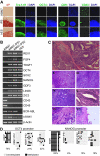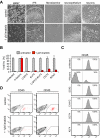Generation of iPSCs from cultured human malignant cells
- PMID: 20233975
- PMCID: PMC2875096
- DOI: 10.1182/blood-2009-07-231845
Generation of iPSCs from cultured human malignant cells
Abstract
Induced pluripotent stem cells (iPSCs) can be generated from various differentiated cell types by the expression of a set of defined transcription factors. So far, iPSCs have been generated from primary cells, but it is unclear whether human cancer cell lines can be reprogrammed. Here we describe the generation and characterization of iPSCs derived from human chronic myeloid leukemia cells. We show that, despite the presence of oncogenic mutations, these cells acquired pluripotency by the expression of 4 transcription factors and underwent differentiation into cell types derived of all 3 germ layers during teratoma formation. Interestingly, although the parental cell line was strictly dependent on continuous signaling of the BCR-ABL oncogene, also termed oncogene addiction, reprogrammed cells lost this dependency and became resistant to the BCR-ABL inhibitor imatinib. This finding indicates that the therapeutic agent imatinib targets cells in a specific epigenetic differentiated cell state, and this may contribute to its inability to fully eradicate disease in chronic myeloid leukemia patients.
Figures


Similar articles
-
Targeting of GSK3β promotes imatinib-mediated apoptosis in quiescent CD34+ chronic myeloid leukemia progenitors, preserving normal stem cells.Blood. 2012 Mar 8;119(10):2335-45. doi: 10.1182/blood-2011-06-361261. Epub 2012 Jan 18. Blood. 2012. PMID: 22262776
-
Persistence of malignant hematopoietic progenitors in chronic myelogenous leukemia patients in complete cytogenetic remission following imatinib mesylate treatment.Blood. 2003 Jun 15;101(12):4701-7. doi: 10.1182/blood-2002-09-2780. Epub 2003 Feb 6. Blood. 2003. PMID: 12576334
-
Generation of disease-specific induced pluripotent stem cells from patients with different karyotypes of Down syndrome.Stem Cell Res Ther. 2012 Apr 18;3(2):14. doi: 10.1186/scrt105. Stem Cell Res Ther. 2012. PMID: 22512921 Free PMC article.
-
Mechanism of Induction: Induced Pluripotent Stem Cells (iPSCs).J Stem Cells. 2015;10(1):43-62. J Stem Cells. 2015. PMID: 26665937 Review.
-
New Bcr-Abl inhibitors in chronic myeloid leukemia: keeping resistance in check.Expert Opin Investig Drugs. 2008 Jun;17(6):865-78. doi: 10.1517/13543784.17.6.865. Expert Opin Investig Drugs. 2008. PMID: 18491988 Review.
Cited by
-
Modeling of Chronic Myeloid Leukemia: An Overview of In Vivo Murine and Human Xenograft Models.Stem Cells Int. 2016;2016:1625015. doi: 10.1155/2016/1625015. Epub 2016 Aug 25. Stem Cells Int. 2016. PMID: 27642303 Free PMC article. Review.
-
Dissecting the role of aberrant DNA methylation in human leukaemia.Nat Commun. 2015 May 22;6:7091. doi: 10.1038/ncomms8091. Nat Commun. 2015. PMID: 25997600 Free PMC article.
-
Concise review: Cancer cell reprogramming and therapeutic implications.Transl Oncol. 2022 Oct;24:101503. doi: 10.1016/j.tranon.2022.101503. Epub 2022 Aug 4. Transl Oncol. 2022. PMID: 35933935 Free PMC article.
-
Myc transcription factors: key regulators behind establishment and maintenance of pluripotency.Regen Med. 2010 Nov;5(6):947-59. doi: 10.2217/rme.10.79. Regen Med. 2010. PMID: 21082893 Free PMC article. Review.
-
Human induced pluripotent stem cells from basic research to potential clinical applications in cancer.Biomed Res Int. 2013;2013:430290. doi: 10.1155/2013/430290. Epub 2013 Oct 28. Biomed Res Int. 2013. PMID: 24288679 Free PMC article. Review.
References
-
- Sieber OM, Tomlinson SR, Tomlinson IPM. Tissue, cell and stage specificity of (epi)mutations in cancers. Nat Rev Cancer. 2005;5(8):649–655. - PubMed
-
- Takahashi K, Yamanaka S. Induction of pluripotent stem cells from mouse embryonic and adult fibroblast cultures by defined factors. Cell. 2006;126(4):663–676. - PubMed
-
- Wernig M, Meissner A, Foreman R, et al. In vitro reprogramming of fibroblasts into a pluripotent ES-cell-like state. Nature. 2007;448(7151):318–324. - PubMed
Publication types
MeSH terms
Substances
Grants and funding
LinkOut - more resources
Full Text Sources
Other Literature Sources
Medical
Miscellaneous

